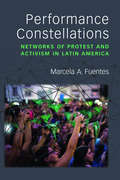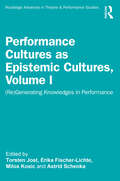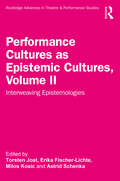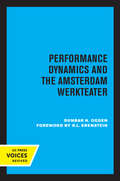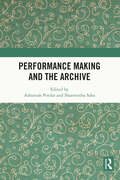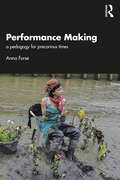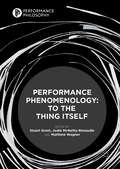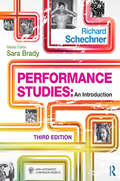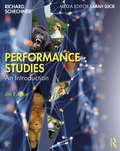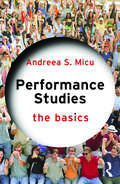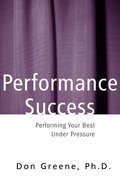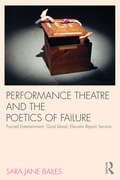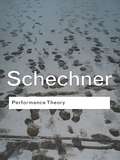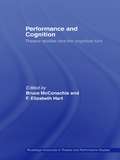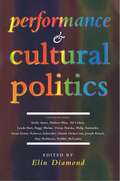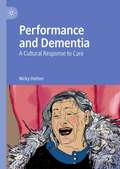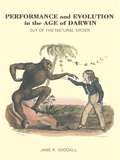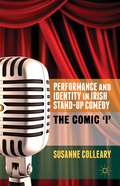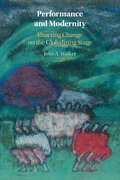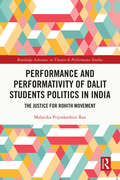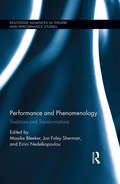- Table View
- List View
Performance Constellations: Networks of Protest and Activism in Latin America (Theater: Theory/Text/Performance)
by Marcela A FuentesPerformance Constellations maps transnational protest movements and the dynamics of networked expressive behavior in the streets and online, as people struggle to be heard and effect long-term social justice. Its case studies explore collective political action in Latin America, including the Zapatistas in the mid-’90s, protests during the 2001 Argentine economic crisis, the 2011 Chilean student movement, the 2014–2015 mobilizations for the disappeared Ayotzinapa students, and the 2018 transnational reproductive rights movement. The book analyzes uses of space, time, media communication, and corporeality in protests such as virtual sit-ins, flash mobs, scarfazos, and hashtag campaigns, arguing that these protests not only challenge hegemonic power but are also socially transformative. While other studies have focused either on digital activism or on street protests, Performance Constellations shows that they are in fact integrally entwined. Zooming in on protest movements and art-activism in Mexico, Argentina, and Chile, and putting contemporary insurgent actions in dialogue with their historical precedents, the book demonstrates how, even in moments of extreme duress, social actors in Latin America have taken up public and virtual space to intervene politically and to contest dominant powers.
Performance Cultures as Epistemic Cultures, Volume I: (Re)Generating Knowledges in Performance (Routledge Advances in Theatre & Performance Studies)
by Torsten Jost, Erika Fischer-Lichte, Milos Kosic and Astrid SchenkaThis volume investigates performances as situated "machineries of knowing" (Karin Knorr Cetina), exploring them as relational processes for, in and with which performers as well as spectators actively (re)generate diverse practices of knowing, knowledges and epistemologies. Performance cultures are distinct but interconnected environments of knowledge practice. Their characteristic features depend not least on historical as well as contemporary practices and processes of interweaving performance cultures. The book presents case studies from diverse locations around the globe, including Argentina, Canada, China, Greece, India, Poland, Singapore, and the United States. Authored by leading scholars in theater, performance and dance studies, its chapters probe not only what kinds of knowledges are (re)generated in performances, for example cultural, social, aesthetic and/or spiritual knowledges; the contributions investigate also how performers and spectators practice knowing (and not-knowing) in performances, paying particular attention to practices and processes of interweaving performance cultures and the ways in which they contribute to shaping performances as dynamic "machineries of knowing" today. Ideal for researchers, students and practitioners of theater, performance and dance, (Re)Generating Knowledges in Performance explores vital knowledge-serving functions of performance, investigating and emphasizing in particular the impact and potential of practices and processes of interweaving of performance cultures that enable performers and spectators to (re)generate crucial knowledges in increasingly diverse ways.
Performance Cultures as Epistemic Cultures, Volume II: Interweaving Epistemologies (Routledge Advances in Theatre & Performance Studies)
by Torsten Jost, Erika Fischer-Lichte, Milos Kosic and Astrid SchenkaThis volume investigates performance cultures as rich and dynamic environments of knowledge practice through which distinctive epistemologies are continuously (re)generated, cultivated and celebrated. Epistemologies are dynamic formations of rules, tools and procedures not only for understanding but also for doing knowledges. This volume deals in particular with epistemological challenges posed by practices and processes of interweaving performance cultures. These challenges arise in artistic and academic contexts because of hierarchies between epistemologies. European colonialism worked determinedly, violently and often with devastating effects on instituting and sustaining a hegemony of modern Euro-American rules of knowing in many parts of the world. Therefore, Interweaving Epistemologies critically interrogates the (im)possibilities of interweaving epistemologies in artistic and academic contexts today. Writing from diverse geographical locations and knowledge cultures, the book’s contributors—philosophers and political scientists as well as practitioners and scholars of theater, performance and dance—investigate prevailing forms of epistemic ignorance and violence. They introduce key concepts and theories that enable critique of unequal power relations between epistemologies. Moreover, contributions explore historical cases of interweaving epistemologies and examine innovative present-day methods of working across and through epistemological divides in nonhegemonic, sustainable, creative and critical ways. Ideal for practitioners, students and researchers of theater, performance and dance, Interweaving Epistemologies emphasizes the urgent need to acknowledge, study and promote epistemological plurality and diversity in practices of performance-making as well as in scholarship on theater and performance around the globe today.
Performance Dynamics and the Amsterdam Werkteater
by Dunbar H. OgdenThis title is part of UC Press's Voices Revived program, which commemorates University of California Press’s mission to seek out and cultivate the brightest minds and give them voice, reach, and impact. Drawing on a backlist dating to 1893, Voices Revived makes high-quality, peer-reviewed scholarship accessible once again using print-on-demand technology. This title was originally published in 1987.
Performance Making and the Archive
by Sharmistha Saha Ashutosh PotdarThis book investigates theories and practices shaped by a performance’s relationship to the archive. The contributions in the volume examine how the changing nature of performance practices has made it imperative to understand how the archive and archival practices could add to the performance work. They explore a variety of themes, including artistic engagement with the archive in both conceptual and material terms; physical, virtual and digital forms; publicly and privately collected; oral, written and digital ways; or organized and unorganized collections. Finally, the volume examines how archives are modelled on existing structure and the ways in which they can be brought into discourses and practices of performance making through engagement and contestation. A novel approach to performance theory, this volume will be of great interest to scholars and researchers of performance studies, media and culture studies, studies of technology and art as also literature and literary criticism.
Performance Making: a pedagogy for precarious times
by Anna FurseSurveying how Performance as a form has evolved as a distinct artistic sector to where it is today, Performance Making: a pedagogy for precarious times provides insight into the impact the artform has had across the creative sector and argues for its defence in higher education today.Drawing on over 40+ years’ worth of experience as artist and academic, Anna Furse interrogates the ways in which the practice of Performance is truly interdisciplinary, offering a specific creative and critical practice approach. Chapters address the neo-liberal turn and its effect on culture; the history of the emergence of the genre within Performance Studies; the underlying political and cultural message of Performance as independent and necessary; wider philosophical and critical theoretical thinking that can support innovation within the field; and the key principles in the creation of live work such as space, site, scenography, the body, collaboration, and composition. Each chapter includes an essay, case studies, and exercises, empowering students to apply critical thinking to their own work.Focusing on developing creative-critical methodologies in Performance Making at postgraduate level for international cohorts, this textbook will equip students, instructors, and practitioners to contextualise and enrich their Performance practice and leadership.
Performance Phenomenology: To The Thing Itself (Performance Philosophy)
by Stuart Grant Jodie McNeilly-Renaudie Matthew WagnerThis collection of essays addresses emergent trends in the meeting of the disciplines of phenomenology and performance. It brings together major scholars in the field, dealing with phenomenological approaches to dance, theatre, performance, embodiment, audience, and everyday performance of self. It argues that despite the wide variety of philosophical, ontological, epistemological, historical and methodological differences across the field of phenomenology, certain tendencies and impulses are required for an investigation to stand as truly phenomenological. These include: description of experience; a move towards fundamental conditions or underlying essences; and an examination of taken-for-granted presuppositions. The book is aimed at scholars and practitioners of performance looking to deepen their understanding of phenomenological concepts and methods, and philosophers concerned with issues of embodiment, performativity and enaction.
Performance Studies
by Richard SchechnerThe publication of Performance Studies: An Introduction was a defining moment for the field. Richard Schechner's pioneering textbook provides a lively and accessible overview of the full range of performance for undergraduates at all levels and beginning graduate students in performance studies, theatre, performing arts, and cultural studies. Among the topics discussed are the performing arts and popular entertainments, rituals, play and games, and the performances of everyday life. Supporting examples and ideas are drawn from the social sciences, performing arts, poststructuralism, ritual theory, ethology, philosophy, and aesthetics. This third edition is accompanied by an all-new companion website curated by a dedicated media editor, with the following resources for instructors and students: Interactive glossary Multiple choice questions Powerpoint Slides. Videos Website links for further study Tutorials on specific skills within Performance Studies Sample Discussion Questions Exercises and Activities Sample Syllabi The book itself has also been revised, with 25 new extracts and biographies, up-to-date coverage of global and intercultural performances, and further exploration of the growing international presence of Performance Studies as a discipline. Performance Studies is the definitive overview for undergraduates, with primary extracts, student activities, key biographies and over 200 images of global performance.
Performance Studies: An Introduction
by Richard SchechnerRichard Schechner's pioneering textbook is a lively, accessible overview of the full range of performance, with primary extracts, student activities, key biographies, and over 200 images of global performance. The publication of Performance Studies: An Introduction was a defining moment for the field. This fourth edition has been revised with two new chapters, up-to-date coverage of global and intercultural performances, and an in-depth exploration of the growing international importance of Performance Studies. Among the book’s topics are the performing arts and popular entertainments, rituals, play and games, social media, the performances of the paleolithic period, and the performances of everyday life. Supporting examples and ideas are drawn from the social sciences, performing arts, poststructuralism, ritual theory, ethology, philosophy, and aesthetics. Performance Studies: An Introduction features the broadest and most in-depth analysis possible. Performance Studies: An Introduction is the definitive overview for undergraduates at all levels and beginning graduate students in performance studies, the performing arts, and cultural studies. This new edition is also supported by a fully updated companion website, offering a variety of interactive resources, teaching tools, and research links.
Performance Studies: The Basics (The Basics)
by Andreea S. MicuPerformance Studies: The Basics offers an overview of the multiple, often overlapping definitions of performance, from performance art, performance as everyday life, and rituals, to the performative dimensions of identity, such as gender, race and sexuality. This book defines the interdisciplinary field of performance studies as it has evolved over the past four decades at the intersection of academic scholarship and artistic and activist practices. It discusses performance as an important means of communicating and of understanding the world, highlighting its intersections with critical theory and arguing for the importance of performance in the study of human behaviour and social practices. Complete with a helpful glossary and bibliography, as well as suggestions for further reading, this book is an ideal starting point for those studying performance studies as well as for general readers with an interest in the subject.
Performance Success: Performing Your Best Under Pressure
by Don GreenePerformance Success teaches a set of skills so that a musician can be ready to go out and sing or play at his or her highest level, working with energies that might otherwise be wasted in unproductive ways. This is a book of skills and exercises, prepared by a master teacher.
Performance Theatre and the Poetics of Failure
by Sara Jane BailesWhat does it mean to "fail" in performance? How might staging failure reveal theatre’s potential to expand our understanding of social, political and everyday reality? What can we learn from performances that expose and then celebrate their ability to fail? In Performance Theatre and the Poetics of Failure, Sara Jane Bailes begins with Samuel Beckett and considers failure in performance as a hopeful strategy. She examines the work of internationally acclaimed UK and US experimental theatre companies Forced Entertainment, Goat Island and Elevator Repair Service, addressing accepted narratives about artistic and cultural value in contemporary theatre-making. Her discussion draws on examples where misfire, the accidental and the intentionally amateur challenge our perception of skill and virtuosity in such diverse modes of performance as slapstick and punk. Detailed rehearsal and performance analysis are used to engage theory and contextualise practice, extending the dialogue between theatre arts, live art and postmodern dance. The result is a critical account of performance theatre that offers essential reading for practitioners, scholars and students of Performance, Theatre and Dance Studies.
Performance Theory
by Richard SchechnerFew have had quite as much impact in both the academy and in the world of theatre production as Richard Schechner. For more than four decades his work has challenged conventional definitions of theatre, ritual and performance. When this seminal collection first appeared, Schechner's approach was not only novel, it was revolutionary: drama is not just something that occurs on stage, but something that happens in everyday life, full of meaning, and on many different levels. Within these pages he examines the connections between Western and non-Western cultures, theatre and dance, anthropology, ritual, performance in everyday life, rites of passage, play, psychotherapy and shamanism.
Performance and Cognition: Theatre Studies and the Cognitive Turn (Routledge Advances in Theatre & Performance Studies)
by Bruce McConachie F. Elizabeth HartThis anthology is the first of its kind. In addition to opening up fresh perspectives on theatre studies – with applications for dramatic criticism, performance analysis, acting practice, audience response, theatre history, and other important areas – the book sets the agenda for future work, helping to map the emergence of this new approach. Following a comprehensive introduction, the contributors examine: the interfaces between cognitive studies and Lacanian psychoanalysis, phenomenology and communication theory different ideas from cognitive studies that open up the meanings of several plays the process of acting and the work of Antonio Damasio theatrical response: the dynamics of perception, and the riots that greeted the 1907 production of The Playboy of the Western World. This original and authoritative work will be attractive to scholars and graduate students of drama, theatre, and performance.
Performance and Cultural Politics
by Elin DiamondPerformance and Cultural Politics is a groundbreaking collection of essays which explore the historical and cultural territories of performance, written by the foremost scholars in the field. The essays, exploring performance art, theatre, music and dance, range from Oscar Wilde to Eric Clapton; from the Rose Theatre to U.S. Holocaust museums. The topic includes: * Sex Play: Stereotype, Pose and Dildo * Grave Performances: The Cultural Politics of Memory * Genealogies: Critical Performances * Identity Politics: Passing, Carnival and the Law In the concluding section, `Performer's Performance', performance artist Robbie McCauley offers the practitioner's perspective on performance studies. Interdisciplinary, thought-provoking and rich in new ideas, Performance and Cultural Politics is a landmark in the emerging field of performance studies.
Performance and Dementia: A Cultural Response to Care
by Nicky HattonThis book explores how theatre and performance can change the way we think about dementia and some of the environments in which dementia care takes place. Drawing on the author’s creative practice and other performance projects in the UK, it explores some of the challenges and opportunities of making performance in care homes. Rather than focusing on the transformative potential of the arts, it asks how artists can engage with the different types of relationships that exist in a care community. These include the relationships that residents and staff have with each other as well as relationships with care spaces. Exploring the intersection between participatory performance and the everyday creativity of a care home, it argues that the arts have a cultural role to play in supporting dementia care as a relational practice. Moreover, it celebrates the intrinsic creativity of caregiving and how principles and practices of care work can inform theatre and performance in diverse ways.
Performance and Evolution in the Age of Darwin: Out of the Natural Order
by Jane GoodallPerformance and Evolution in the Age of Darwin reveals the ways in which the major themes of evolution were taken up in the performing arts during Darwin's adult lifetime and in the generation after his death. The period 1830-1900 was the formative period for evolutionary ideas. While scientists and theorists investigated the law and order of nature, show business was more concerned with what was out of the natural order. Missing links and throwbacks, freak taxonomies and exotic races were favourite subject matter for the burgeoning variety theatre movement. Focusing on popular theatre forms in London, New York and Paris, Jane Goodall shows how they were interwoven with the developing debate about human evolution. With this book, Goodall contributes an important new angle to the debates surrounding the history of evolution. She reveals that, far from creating widespread culture shock, Darwinian theory tapped into some of the long-standing themes of popular performance and was a source for diverse and sometimes hilarious explorations.
Performance and Identity in Irish Stand-Up Comedy: The Comic 'i'
by S. CollearyOne of the cultural phenomena to occur in Ireland in the last two decades has been the highly successful growth of stand-up comedy as a popular entertainment genre. This book examines stand-up comedy from the perspective of the narrated self, through the prism of the fabricated comedy persona, including Tommy Tiernan, Dylan Moran and Maeve Higgins.
Performance and Identity in the Classical World
by Anne DuncanActors in the classical world were often viewed as frauds and impostors, capable of deliberately fabricating their identities. Conversely, they were sometimes viewed as possessed by the characters that they played, or as merely playing themselves onstage. Numerous sources reveal an uneasy fascination with actors and acting, from the writings of elite intellectuals (philosophers, orators, biographers, historians) to the abundant theatrical anecdotes that can be read as a body of "popular performance theory. " This study examines these sources, along with dramatic texts and addresses the issue of impersonation, from the late fifth century BCE to the early Roman Empire.
Performance and Modernity: Enacting Change on the Globalizing Stage
by Julia A. WalkerHow do ideas take shape? How do concepts emerge into form? This book argues that they take shape quite literally in the human body, often appearing on stage in new styles of performance. Focusing on the historical period of modernity, Performance and Modernity: Enacting Change on the Globalizing Stage demonstrates how the unforeseen impact of economic, industrial, political, social, and psychological change was registered in bodily metaphors that took shape on stage. In new styles of performance-acting, dance, music, pageantry, avant-garde provocations, film, video and networked media-this book finds fresh evidence for how modernity has been understood and lived, both by stage actors, who, in modelling new habits, gave emerging experiences an epistemological shape, and by their audiences, who, in borrowing the strategies performers enacted, learned to adapt to a modernizing world.
Performance and Performativity of Dalit Students Politics in India: The Justice for Rohith Movement (Routledge Advances in Theatre & Performance Studies)
by Malavika Priyadarshini RaoThis book examines the significance of body, space, sound/voice/music and objects of resistance in everyday performance of Dalit student protests, focusing on the protests which erupted after Rohith Vemula, a Dalit PhD student, died,by suicide in Hyderabad Central University on 17 January 2016 in Hyderabad, India.Rohith’s death sparked national and international outrage and led to the shutdown of the University for over a month and gave rise to the ‘Justice for Rohith movement’, which continued for over a year. Rohith’s death became a symbolic representation of other Dalit deaths due to systemic caste violence; the symbolism of his death expanded to include other marginalised groups who have faced systemic violence historically. The author highlights five distinct aesthetics prominent in Dalit student activist performance practices: (1) folk performance traditions; (2) counter-interpretation and representation of Hindu mythology and Hinduism; (3) inspiration from Ambedkar and Buddhist iconography; (4) Christian church hymns; and (5) the text of Rohith’s last letter.In each chapter, the book explores how protesters draw on aesthetics and strategies from other political movements. This book will be of great interest to students and scholars in theatre and performance studies.
Performance and Phenomenology: Traditions and Transformations (Routledge Advances in Theatre & Performance Studies)
by Maaike Bleeker Jon Foley Sherman Eirini NedelkopoulouThis book offers a timely discussion about the interventions and tensions between two contested and contentious fields, performance and phenomenology, with international case studies that map an emerging 21st century terrain of critical and performance practice. Building on the foundational texts of both fields that established the performativity of perception and cognition, Performance and Phenomenology continues a tradition that considers experience to be the foundation of being and meaning. Acknowledging the history and critical polemics against phenomenological methodology and against performance as a field of study and category of artistic production, the volume provides both an introduction to core thinkers and an expansion on their ideas in a wide range of case studies. Whether addressing the use of dead animals in performance, actor training, the legal implications of thinking phenomenologically about how we walk, or the intertwining of digital and analog perception, each chapter explores a world comprised of embodied action and thought. The established and emerging scholars contributing to the volume develop insights central to the phenomenological tradition while expanding on the work of contemporary theorists and performers. In asking why performance and phenomenology belong in conversation together, the book suggests how they can transform each other in the process and what is at stake in this transformation.
Performance and Posthumanism: Staging Prototypes of Composite Bodies
by Christel Stalpaert Kristof Van Baarle Laura KarremanRecent technological and scientific developments have demonstrated a condition that has already long been upon us. We have entered a posthuman era, an assertion shared by an increasing number of thinkers such as N. Katherine Hayles, Rosi Braidotti, Donna Haraway, Bruno Latour, Richard Grusin, and Bernard Stiegler. The performing arts have reacted to these developments by increasingly opening up their traditionally ‘human’ domain to non-human others. Both philosophy and performing arts thus question what it means to be human from a posthumanist point of view and how the agency of non-humans – be they technology, objects, animals, or other forms of being – ‘works’ on both an ontological and performative level. The contributions in this volume brings together scholars, dramaturgs, and artists, uniting their reflections on the consequences of the posthuman condition for creative practices, spectatorship, and knowledge.
Performance and Postsocialism in Postmillennial China (Elements in Theatre, Performance and the Political)
by Rossella FerrariThis Element examines performance in postmillennial China through the lens of postsocialism. The fragmented ontology of Chinese postsocialism captures the structural contradictions of a political system that supports a neoliberal economy while continuing to promote socialist values. This study explores how the ideological ambivalence and cultural paradoxes that characterise the postsocialist condition are embodied and represented in performance. Focusing on independent practitioners and postdramatic practices, it builds on theorisations of postsocialism as a state of temporal disjunction to propose a tripartite taxonomy structured around past, present, and future temporal regimes. The categories of postsocialist hauntologies, postsocialist realisms, and postsocialist futurities are introduced to investigate performance works that respectively revisit the socialist past, document present realities, and envision future imaginations. The intersection of competing temporalities and their performative manifestations reflects the disjunctive constitution of contemporary China, where past socialist legacies and futurological ambitions coexist within a fractured postsocialist present.
Performance and Professional Wrestling
by Claire Warden Broderick Chow Eero LainePerformance and Professional Wrestling is the first edited volume to consider professional wrestling explicitly from the vantage point of theatre and performance studies. Moving beyond simply noting its performative qualities or reading it via other performance genres, this collection of essays offers a complete critical reassessment of the popular sport.Topics such as the suspension of disbelief, simulation, silence and speech, physical culture, and the performance of pain within the squared circle are explored in relation to professional wrestling, with work by both scholars and practitioners grouped into seven short sections: Audience Circulation Lucha Gender Queerness Bodies Race A significant re-reading of wrestling as a performing art, Performance and Professional Wrestling makes essential reading for scholars and students intrigued by this uniquely theatrical sport.
